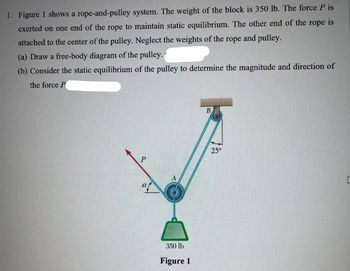Question
Needs Complete solution with 100 % accuracy.

Transcribed Image Text:1. Figure 1 shows a rope-and-pulley system. The weight of the block is 350 lb. The force P is
exerted on one end of the rope to maintain static equilibrium. The other end of the rope is
attached to the center of the pulley. Neglect the weights of the rope and pulley.
(a) Draw a free-body diagram of the pulley.
(b) Consider the static equilibrium of the pulley to determine the magnitude and direction of
the force P
P
350 lb
Figure 1
B
25°
[
Expert Solution
This question has been solved!
Explore an expertly crafted, step-by-step solution for a thorough understanding of key concepts.
Step by stepSolved in 4 steps with 3 images

Knowledge Booster
Similar questions
arrow_back_ios
SEE MORE QUESTIONS
arrow_forward_ios